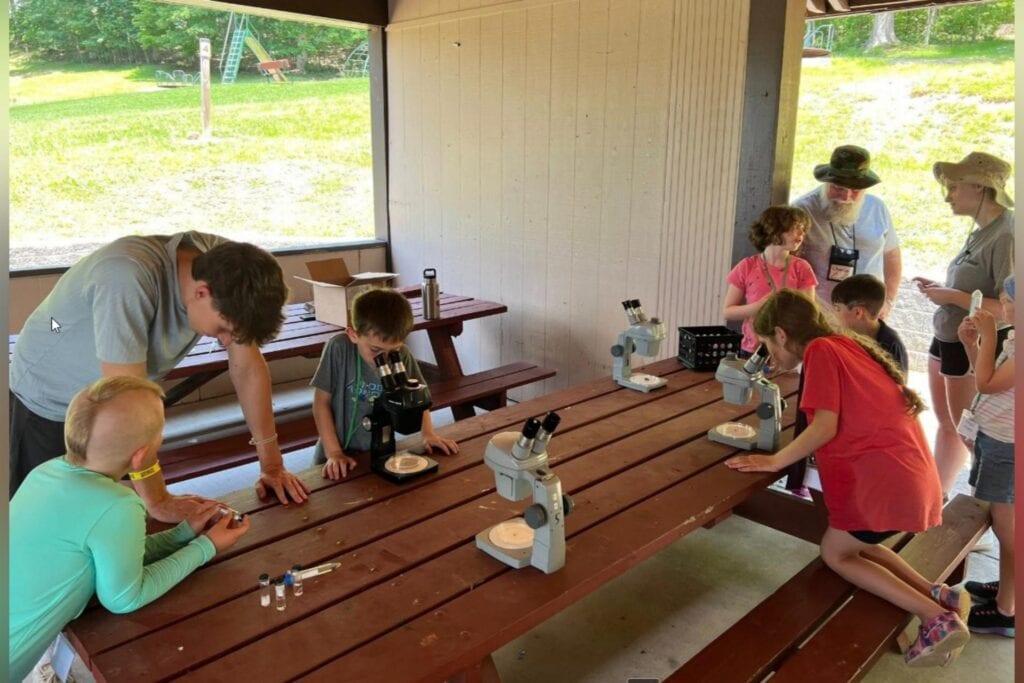BUCKHANNON – From the field to the lab, three West Virginia Wesleyan College students worked this summer to identify Upshur County ticks and check them for Lyme bacteria.
The project is overseen by Dr. Melanie Sal, Department of Biology and Environmental Science chair, and Dr. Kim Bjorgo-Thorne, Associate Professor of Biology and Environmental Science. The students worked under Maier Foundation and Summer Undergraduate Research (SURE) grant funds secured by Dr. Joanna Webb.
Starting in mid-May, Kaelin Withrow ’23, of St. Alban’s, Haley Zinn ’22, of Tunnelton, and Nathan White ’22, of Camden, collected ticks throughout Upshur County. The students also obtained ticks from participating local veterinarians and groomers.
Those ticks were photographed and analyzed in the lab to identify the species of tick, its life stage, and sex. The students then extracted DNA from the ticks.
“We want to see if the ticks around Upshur County carry any vector-borne diseases and the first one we are looking for is Lyme disease, which is caused by the bacterium Borrelia burgdorferi,” Sal said. Bjorgo-Thorne added “Borrelia lives inside the gut of a specific tick, the black-legged or deer tick. When a deer tick attaches and feeds from a human or pet, the bacteria can be transferred, resulting in Lyme disease.”
Although the project’s overall purpose is helping the Upshur County community, it also has helped the students involved determine next steps in their career path or graduate school.
Withrow said this research project took her out of her comfort zone as she is more focused on molecular biology in her major.
“I don’t normally do a lot of ecological studies,” she said. “I learned a lot about the realities of research that everything isn’t as straightforward as you would think. I feel like even continuing this research in the fall will help me decide what route I want to take with my degree after I graduate.”
Zinn said getting to participate in both field and lab work was the best of both worlds for her.
“I knew it was going to help me build my skills going into grad school,” she said. “I am hoping to do environmental conservation and this helps me decide that and gives me more options.”
As a freshman, White saw the initial student research tick team and became interested in their project.
“I wanted to be a part of that somehow,” he said. “I’m planning on going to graduate school and this gives me the background that I need to be that candidate that stands out. I knew I loved field work, but this gave me a background in lab work that I have not fine-tuned yet.”
As the project progresses, the research team would like to use this information to help the Upshur County community know where a prevalence of ticks carrying vector-borne diseases like Lyme disease may be habituating.
Bjorgo-Thorne added “We want people to know they should be aware of ticks when spending time outside. People and pets should be protected with repellent. When you come back inside, check carefully for ticks, If you find a tick, remove it appropriately and promptly. Monitor the site for any redness or rash, and, if one develops, contact your healthcare provider” said Bjorgo-Thorne.
So far, these students have expressed an interest in continuing research in the fall.
“The next phase is we would like to branch out and look for more than just Lyme disease in ticks,” Sal said.
“We know that ticks have the potential to carry one or more diseases.”
For example, dog ticks have the potential to carry other diseases that cause Rocky Mountain Spotted Fever.
“Because we find those ticks in this area, Lyme disease isn’t the only vector-borne disease we need to worry about,” she said.
The summer research project was recently featured on WCHSTV’s “Wild Appalachia” series and can be viewed here.













